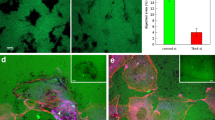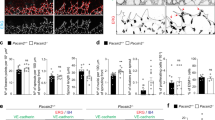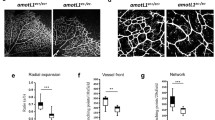Abstract
Transmembrane-4-L-six-family-1 (TM4SF1) is a tetraspanin-like membrane protein that is highly and selectively expressed by cultured endothelial cells (EC) and, in vivo, by EC lining angiogenic tumor blood vessels. TM4SF1 is necessary for the formation of unusually long (up to a 50 μm), thin (~100–300 nm wide), F-actin-poor EC cell projections that we term ‘nanopodia’. Immunostaining of nanopodia at both the light and electron microsopic levels localized TM4SF1 in a regularly spaced, banded pattern, forming TM4FS1-enriched domains. Live cell imaging of GFP-transduced HUVEC demonstrated that EC project nanopodia as they migrate and interact with neighboring cells. When TM4SF1 mRNA levels in EC were increased from the normal ~90 mRNA copies/cell to ~400 copies/cell through adenoviral transduction, EC projected more and longer nanopodia from the entire cell circumference but were unable to polarize or migrate effectively. When fibroblasts, which normally express TM4SF1 at ~5 copies/cell, were transduced to express TM4SF1 at EC-like levels, they formed typical TM4SF1-banded nanopodia, and broadened, EC-like lamellipodia. Mass-spectrometry demonstrated that TM4SF1 interacted with myosin-10 and β-actin, proteins involved in filopodia formation and cell migration. In summary, TM4SF1, like genuine tetraspanins, serves as a molecular organizer that interacts with membrane and cytoskeleton-associated proteins and uniquely initiates the formation of nanopodia and facilitates cell polarization and migration.





Similar content being viewed by others
References
Hemler ME (2005) Tetraspanin functions and associated microdomains. Nat Rev Mol Cell Biol 6(10):801–811
Hemler ME (2008) Targeting of tetraspanin proteins: potential benefits and strategies. Nat Rev Drug Discov 7(9):747–758
Wright MD, Ni J, Rudy GB (2000) The L6 membrane proteins: a new four-transmembrane superfamily. Protein Sci 9(8):1594–1600
Hellstrom I, Horn D, Linsley P, Brown JP, Brankovan V, Hellstrom KE (1986) Monoclonal mouse antibodies raised against human lung carcinoma. Cancer Res 46(8):3917–3923
Chang YW, Chen SC, Cheng EC, Ko YP, Lin YC, Kao YR, Tsay YG, Yang PC, Wu CW, Roffler SR (2005) CD13 (aminopeptidase N) can associate with tumor-associated antigen L6 and enhance the motility of human lung cancer cells. Int J Cancer 116(2):243–252
Kao YR, Shih JY, Wen WC, Ko YP, Chen BM, Chan YL, Chu YW, Yang PC, Wu CW, Roffler SR (2003) Tumor-associated antigen L6 and the invasion of human lung cancer cells. Clin Cancer Res 9(7):2807–2816
Shih SC, Zukauskas A, Li D, Liu G, Ang LH, Nagy JA, Brown LF, Dvorak HF (2009) The L6 protein TM4SF1 is critical for endothelial cell function and tumor angiogenesis. Cancer Res 69(8):3272–3277
Takahashi T, Takahashi K, Daniel TO (1999) High-efficiency and low-toxicity adenovirus-assisted endothelial transfection. In: Baker AH (ed) Methods in molecular medicine, vascular disease: molecular biology and gene therapy protocols. ©Humana Press, Totowa, pp 307–314
Shih SC, Smith LE (2005) Quantitative multi-gene transcriptional profiling using real-time PCR with a master template. Exp Mol Pathol 79(1):14–22
Wada Y, Li D, Merley A, Zukauskas A, Aird WC, Dvorak HF, Shih SC (2010) A multi-gene transcriptional profiling approach to the discovery of cell signature markers. Cytotechnology 63(1):25–33
Brown LF, Lanir N, McDonagh J, Tognazzi K, Dvorak AM, Dvorak HF (1993) Fibroblast migration in fibrin gel matrices. Am J Pathol 142(1):273–283
Rodriguez LG, Wu X, Guan JL (2005) Wound-healing assay. Methods Mol Biol 294:23–29
Deissler H, Kuhn EM, Lang GE, Deissler H (2007) Tetraspanin CD9 is involved in the migration of retinal microvascular endothelial cells. Int J Mol Med 20(5):643–652
Marken JS, Schieven GL, Hellstrom I, Hellstrom KE, Aruffo A (1992) Cloning and expression of the tumor-associated antigen L6. Proc Natl Acad Sci USA 89(8):3503–3507
Marken JS, Bajorath J, Edwards CP, Farr AG, Schieven GL, Hellstrom I, Hellstrom KE, Aruffo A (1994) Membrane topology of the L6 antigen and identification of the protein epitope recognized by the L6 monoclonal antibody. J Biol Chem 269(10):7397–7401
Lekishvili T, Fromm E, Mujoomdar M, Berditchevski F (2008) The tumour-associated antigen L6 (L6-Ag) is recruited to the tetraspanin-enriched microdomains: implication for tumour cell motility. J Cell Sci 121(Pt 5):685–694
Berg JS, Derfler BH, Pennisi CM, Corey DP, Cheney RE (2000) Myosin-X: a novel myosin with pleckstrin homology domains, associates with regions of dynamic actin. J Cell Sci 113(Pt 19):3439–3451
Zhang H, Berg JS, Li Z, Wang Y, Lang P, Sousa AD, Bhaskar A, Cheney RE, Stromblad S (2004) Myosin-X provides a motor-based link between integrins and the cytoskeleton. Nat Cell Biol 6(6):523–531
Weber KL, Sokac AM, Berg JS, Cheney RE, Bement WM (2004) A microtubule-binding myosin required for nuclear anchoring and spindle assembly. Nature 431(7006):325–329
Gupton SL, Gertler FB (2007) Filopodia: the fingers that do the walking. Sci STKE 2007(400):re5
Mattila PK, Lappalainen P (2008) Filopodia: molecular architecture and cellular functions. Nat Rev Mol Cell Biol 9(6):446–454
Ohta Y, Suzuki N, Nakamura S, Hartwig JH, Stossel TP (1999) The small GTPase RalA targets filamin–induce filopodia. Proc Natl Acad Sci USA 96(5):2122–2128
Itoh T, De Camilli P (2006) BAR, F-BAR (EFC) and ENTH/ANTH domains in the regulation of membrane-cytosol interfaces and membrane curvature. Biochim Biophys Acta 1761(8):897–912
Ahmed S, Goh WI, Bu W (2009) I-BAR domains, IRSp53 and filopodium formation. Semin Cell Dev Biol 21(4):350–356
Saarikangas J, Zhao H, Pykalainen A, Laurinmaki P, Mattila PK, Kinnunen PK, Butcher SJ, Lappalainen P (2009) Molecular mechanisms of membrane deformation by I-BAR domain proteins. Curr Biol 19(2):95–107
Rustom A, Saffrich R, Markovic I, Walther P, Gerdes HH (2004) Nanotubular highways for intercellular organelle transport. Science 303(5660):1007–1010
Gerdes HH, Carvalho RN (2008) Intercellular transfer mediated by tunneling nanotubes. Curr Opin Cell Biol 20(4):470–475
Wang X, Veruki ML, Bukoreshtliev NV, Hartveit E, Gerdes HH (2010) Animal cells connected by nanotubes can be electrically coupled through interposed gap-junction channels. Proc Natl Acad Sci USA 107(40):17194–17199
Kozma R, Ahmed S, Best A, Lim L (1995) The Ras-related protein Cdc42Hs and bradykinin promote formation of peripheral actin microspikes and filopodia in swiss 3T3 fibroblasts. Mol Cell Biol 15(4):1942–1952
Nobes CD, Hall A (1995) Rho, rac, and cdc42 GTPases regulate the assembly of multimolecular focal complexes associated with actin stress fibers, lamellipodia, and filopodia. Cell 81(1):53–62
Acknowledgments
We thank Dr. Youichiro Wada for helpful discussions. This work was supported by NIH grant P01 CA92644 and by a contract from the National Foundation for Cancer Research.
Author information
Authors and Affiliations
Corresponding authors
Electronic supplementary material
Below is the link to the electronic supplementary material.
Supplementary material 2 (MOV 6,894 kb)
Supplementary material 3 (MOV 16,580 kb)
Rights and permissions
About this article
Cite this article
Zukauskas, A., Merley, A., Li, D. et al. TM4SF1: a tetraspanin-like protein necessary for nanopodia formation and endothelial cell migration. Angiogenesis 14, 345–354 (2011). https://doi.org/10.1007/s10456-011-9218-0
Received:
Accepted:
Published:
Issue Date:
DOI: https://doi.org/10.1007/s10456-011-9218-0




